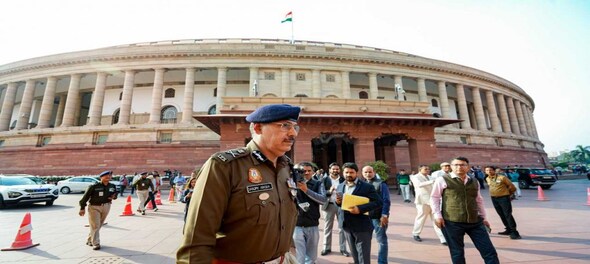
In a major security breach, two men jumped into the Lok Sabha chamber from the visitor’s gallery during the Zero Hour on Wednesday. They shouted slogans and released yellow gas from canisters before being overpowered by the Members of Parliament and the security staff. The incident took place exactly 22 years after the December 13, 2001, attack on the Parliament that had left nine people dead.
According to PTI, the two persons have been identified as Sagar Sharma and Manoranjan. Sharma came to the visitor's gallery as a guest of Mysuru MP Pratap Simha.
#WATCH | An unidentified man jumps from the visitor's gallery of Lok Sabha after which there was a slight commotion and the House was adjourned. pic.twitter.com/Fas1LQyaO4
— ANI (@ANI) December 13, 2023
At the same time, two people, including a woman, sprayed coloured gas from canisters outside the Parliament premises, shouting slogans, 'Tanashahi nahi chalegi'.
“The incident that happened today is a topic of concern for all of us and is serious as well... A high-level investigation is being done and accordingly, action will be taken. A comprehensive review will be done regarding the security in the House... The House is adjourned till 11:00 am tomorrow (Thursday),” Lok Sabha Speaker Om Birla said.
#WATCH | Lok Sabha security breach | Lok Sabha Speaker Om Birla says, "The incident that happened today is a topic of concern for all of us & is serious as well...A high-level investigation is being done & accordingly action will be taken. A comprehensive review will be done… pic.twitter.com/S3SopKopWM
— ANI (@ANI) December 13, 2023
The Parliament is one of the most secure places in the country. However, Wednesday's incident has raised multiple questions over the security process at the new Parliament.
Understanding Parliament's security structure
The additional Secretary (Security) of the Lok Sabha Secretariat is overall in charge of the entire Parliament Security, while the Director (Security) of the Rajya Sabha Secretariat exercises operational control, according to the Parliament security manual.
Following the 2001 attack, when five terrorists entered the Parliament premises and opened fire, leading to the deaths of nine security personnel, the security process at the old Parliament building was overhauled.
The Parliament Security Service looks after the set-up in the Parliament House complex. Also, security agencies like the Delhi Police, Central Reserve Police Force (CRPF), Indo-Tibetan Border Police (ITBP), Special Protection Group (SPG) and the National Security Guard (NSG) are responsible for the safety of MPs at Parliament.
To enter the Parliament premises, there is a three-level security check for all visitors -- first at the entry gate of the premises, second one at the building's entry gate and people have to go through the same process at the corridor that leads to visitor’s gallery.
The new Parliament building has six entrances, with each of them representing a distinct role.
Moreover, the security officials on the premises cross-check the IDs to recognise the staff, including gardeners and sweepers. Everyone is required to carry identity cards daily and are cleared by the Ministry of Home Affairs, which periodically repeats the security checks.
Visitor's Pass
The process of issuing Gallery passes inside the Parliamentary complex is strictly regulated under controlled protocols. Applications can only be submitted on paper or through the Digital Sansad website by the Members of Parliament.
Also, strict measures are in place during sessions to prevent people from obtaining passes. It is worth noting that each pass has a unique ID.
(Edited by : Sudarsanan Mani)
Check out our in-depth Market Coverage, Business News & get real-time Stock Market Updates on CNBC-TV18. Also, Watch our channels CNBC-TV18, CNBC Awaaz and CNBC Bajar Live on-the-go!


Who will succeed Modi? Oppn thinks Amit Shah will, but PM said this
May 21, 2024 2:38 PM
1100 villagers boycott Lok Sabha and Assembly polls in Odisha, here's why
May 21, 2024 10:56 AM

